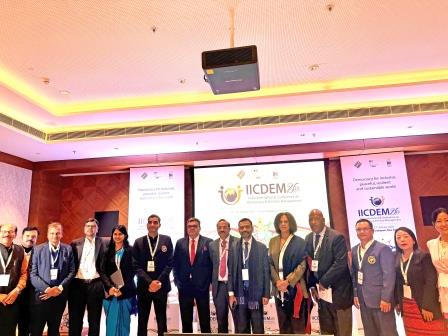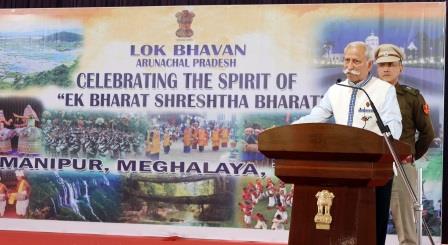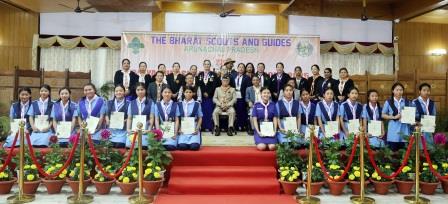-
 Team Arunachal Pradesh participates in IICDEM 2026; leads thematic…
Team Arunachal Pradesh participates in IICDEM 2026; leads thematic…
-
24hr bandh hits normal life in Lower Subansiri
-
 Lok Bhavan celebrates State Foundation Day
Lok Bhavan celebrates State Foundation Day
-
 Arunachal Yuva Samanvay 2026 underway in Namsai
Arunachal Yuva Samanvay 2026 underway in Namsai
-
DA conducts Keyi Panyor Suvidha outreach campaign
-
 Governor confers BSG Rajya Puraskar
Governor confers BSG Rajya Puraskar
-
Pongte stresses use of technology in law-making
-
 Vintage Jeep & Bike Rally commemorates end of World War-II
Vintage Jeep & Bike Rally commemorates end of World War-II
-
ARC partners with AITF, apex CBOs to lead strategic dialogue
-
Dibang Valley administration reviews progress of ongoing schemes
In a landmark decision, the Arunachal Pradesh government recently adopted the ‘Pakke Tiger Reserve 2047 Ministerial Declaration on Climate Change Resilient and Responsive Arunachal Pradesh’ to accelerate comprehensive, smart, climate resilient and inclusive development of the people and state with all-round efforts.
The Declaration envisages a multi-sectoral ‘whole of government- and whole of society- approach’ on the pathway towards low emissions and climate-resilient development through its five broad themes, termed as ‘Panch Dharas’ that, in turn, rest on 75 strategies.
The Panch Dharas comprise ‘Environment, Forest & Climate Change’; ‘Health & Well-being of All’; ‘Sustainable & Adaptive Living’; ‘Livelihoods & Opportunities’ and ‘Evidence Generation & Collaborative Action’.
For the first time, the state cabinet went all the way to the Pakke Tiger Reserve, Pakke Kessang, about 75 km from Itanagar, to hold the cabinet meeting that passed this Declaration. This declaration is a first of its kind by any state government in the country.
Besides, it seeks to synergize the efforts of the state government to realize Sustainable Development Goals (SDGs) in the larger context of climate change.
“The Arunachal Pradesh government would do its best to protect the people from challenges posed by the ongoing climate change and its impacts on biodiversity through addressing both the risks to the economy and the ecosystem,” Khandu had stressed.
Khandu had also highlighted the focus on Research & Development to develop capacities and enhance technical know-how on climate resilience mitigation and responsive strategies through collaboration with academia and think tanks with a priority area being documentation of Traditional Knowledge Systems of Indigenous Communities to preserve and propagate adaptive climate resilient methods and locally sustainable practices.
The first theme, ‘Environment, Forest and Climate Change’ has 23 strategies, including ‘Protect and maintain the Very Dense Forest in Arunachal Pradesh’, ‘Attenuate the drivers of deforestation such as illegal felling encroachment in forest areas’, ‘Increase solar power generation’ and ‘Increase penetration of LED’.
The second theme of ‘Health and Well Being’ has seven strategies; the third theme of ‘Adaptable and Sustainable Living’ has 15 strategies, including ‘Conduct climate risk vulnerability assessment and demarcate hazard-prone zones’ and ‘Promote low carbon transport systems for local commute in all cities and towns’; the fourth theme of ‘Livelihood and Opportunities’ has 20 strategies while the fifth theme of ‘Evidence Generation and Collaborative Action’ has 10 strategies.
On paper the declaration makes news watchers and environmentalists quite upbeat. It is definitely a positive development as it reflects that the government of the day is alive to the problems which is threatening the planet today. However given the track record of the Arunachal Pradesh government one would have to be wary about its translation to reality. We will have to wait and see how it actually rolls out on the ground.
Now that the post event euphoria has died down, we hope the Arunachal government will get to business and work on ensuring the “historic” declaration percolate to the ground. It won’t be an easy task for sure but how about the government proving us wrong this instance.

Kenter Joya Riba
(Managing Editor)She is a graduate in Science with post graduation in Sociology from University of Pune. She has been in the media industry for nearly a decade. Before turning to print business, she has been associated with radio and television.
Email: kenterjoyaz@easternsentinel.in / editoreasternsentinel@gmail.com
Phone: 0360-2212313

